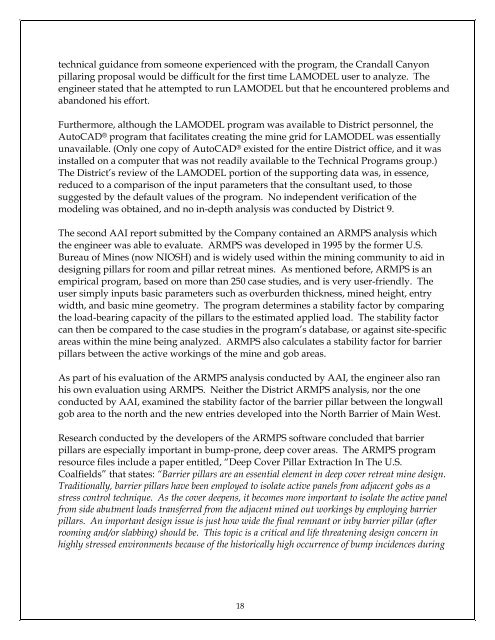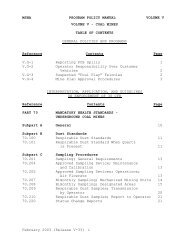Independent Review of MSHA's Actions at Crandall Canyon Mine
Independent Review of MSHA's Actions at Crandall Canyon Mine
Independent Review of MSHA's Actions at Crandall Canyon Mine
Create successful ePaper yourself
Turn your PDF publications into a flip-book with our unique Google optimized e-Paper software.
technical guidance from someone experienced with the program, the <strong>Crandall</strong> <strong>Canyon</strong><br />
pillaring proposal would be difficult for the first time LAMODEL user to analyze. The<br />
engineer st<strong>at</strong>ed th<strong>at</strong> he <strong>at</strong>tempted to run LAMODEL but th<strong>at</strong> he encountered problems and<br />
abandoned his effort.<br />
Furthermore, although the LAMODEL program was available to District personnel, the<br />
AutoCAD ® program th<strong>at</strong> facilit<strong>at</strong>es cre<strong>at</strong>ing the mine grid for LAMODEL was essentially<br />
unavailable. (Only one copy <strong>of</strong> AutoCAD ® existed for the entire District <strong>of</strong>fice, and it was<br />
installed on a computer th<strong>at</strong> was not readily available to the Technical Programs group.)<br />
The District’s review <strong>of</strong> the LAMODEL portion <strong>of</strong> the supporting d<strong>at</strong>a was, in essence,<br />
reduced to a comparison <strong>of</strong> the input parameters th<strong>at</strong> the consultant used, to those<br />
suggested by the default values <strong>of</strong> the program. No independent verific<strong>at</strong>ion <strong>of</strong> the<br />
modeling was obtained, and no in-depth analysis was conducted by District 9.<br />
The second AAI report submitted by the Company contained an ARMPS analysis which<br />
the engineer was able to evalu<strong>at</strong>e. ARMPS was developed in 1995 by the former U.S.<br />
Bureau <strong>of</strong> <strong>Mine</strong>s (now NIOSH) and is widely used within the mining community to aid in<br />
designing pillars for room and pillar retre<strong>at</strong> mines. As mentioned before, ARMPS is an<br />
empirical program, based on more than 250 case studies, and is very user-friendly. The<br />
user simply inputs basic parameters such as overburden thickness, mined height, entry<br />
width, and basic mine geometry. The program determines a stability factor by comparing<br />
the load-bearing capacity <strong>of</strong> the pillars to the estim<strong>at</strong>ed applied load. The stability factor<br />
can then be compared to the case studies in the program’s d<strong>at</strong>abase, or against site-specific<br />
areas within the mine being analyzed. ARMPS also calcul<strong>at</strong>es a stability factor for barrier<br />
pillars between the active workings <strong>of</strong> the mine and gob areas.<br />
As part <strong>of</strong> his evalu<strong>at</strong>ion <strong>of</strong> the ARMPS analysis conducted by AAI, the engineer also ran<br />
his own evalu<strong>at</strong>ion using ARMPS. Neither the District ARMPS analysis, nor the one<br />
conducted by AAI, examined the stability factor <strong>of</strong> the barrier pillar between the longwall<br />
gob area to the north and the new entries developed into the North Barrier <strong>of</strong> Main West.<br />
Research conducted by the developers <strong>of</strong> the ARMPS s<strong>of</strong>tware concluded th<strong>at</strong> barrier<br />
pillars are especially important in bump-prone, deep cover areas. The ARMPS program<br />
resource files include a paper entitled, “Deep Cover Pillar Extraction In The U.S.<br />
Coalfields” th<strong>at</strong> st<strong>at</strong>es: “Barrier pillars are an essential element in deep cover retre<strong>at</strong> mine design.<br />
Traditionally, barrier pillars have been employed to isol<strong>at</strong>e active panels from adjacent gobs as a<br />
stress control technique. As the cover deepens, it becomes more important to isol<strong>at</strong>e the active panel<br />
from side abutment loads transferred from the adjacent mined out workings by employing barrier<br />
pillars. An important design issue is just how wide the final remnant or inby barrier pillar (after<br />
rooming and/or slabbing) should be. This topic is a critical and life thre<strong>at</strong>ening design concern in<br />
highly stressed environments because <strong>of</strong> the historically high occurrence <strong>of</strong> bump incidences during<br />
18

















